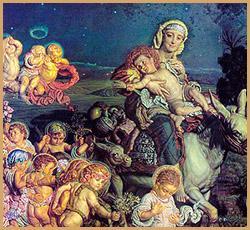By ROSS DOUTHAT (from The New York Times Sunday Review)
NEWTOWN, Conn., is about 20 miles from the town where my wife grew up. It’s the kind of place that rewards rambling New England drives: there are big old Victorian houses flanking the main street, a hill with a huge flagpole rising in the center of town, and a large pasture just below, with shaded side roads radiating outward from the greensward, and then horse farms in the hills beyond.

Any grown-up knows that such small-town innocence is illusory, and that what looks pristine to outsiders can be as darkened by suffering as any other place where human beings live together, and alone.
But even so, the illusion has real power, not least because the dream of small-town life makes the whole universe seem somehow kinder and homier. If only a Bedford Falls or Stars Hollow or Mayberry existed somewhere, we tend to feel — in New England or Nebraska, the present or the past — then perhaps there’s some ultimate hope for the rest of us as well. Maybe the universe really was meant to be a home to humanity, and not just a blindly cruel cosmos in which a 6-year-old’s fate is significant to his parents but no more meaningful in absolute terms than the cracking of a seashell or an extinction of a star.
But if the ideal of the Good Place, the lost Eden or Arcadia, can stir up the residue of religious hopes even in hardened materialists, the reality of what transpired in the real Newtown last week — the murder in cold blood of 20 small children — can make Ivan Karamazovs out of even the devout.
In Fyodor Dostoyevsky’s famous novel, Ivan is the Karamazov brother who collects stories of children tortured, beaten, killed — babes caught on the points of soldiers’ bayonets, a serf boy run down by his master’s hounds, a child of 5 locked in a freezing outhouse by her parents.
Ivan invokes these innocents in a speech that remains one of the most powerful rebukes to the idea of a loving, omniscient God — a speech that accepts the possibility that the Christian story of free will leading to suffering and then eventually redemption might be true, but rejects its Author anyway, on the grounds that the price of our freedom is too high.
“Can you understand,” he asks his more religious sibling, “why a little creature, who can’t even understand what’s done to her, should beat her little aching heart with her tiny fist in the dark and the cold, and weep her meek unresentful tears to dear, kind God to protect her? … Do you understand why this infamy must be and is permitted? Without it, I am told, man could not have existed on earth, for he could not have known good and evil. Why should he know that diabolical good and evil when it costs so much?”
Perhaps, Ivan concedes, there will be some final harmony, in which every tear is wiped away and every human woe is revealed as insignificant against the glories of eternity. But such a reconciliation would be bought at “too high a price.” Even the hope of heaven, he tells his brother, isn’t worth “the tears of that one tortured child.”
It’s telling that Dostoyevsky, himself a Christian, offered no direct theological rebuttal to his character’s speech. The counterpoint to Ivan in “The Brothers Karamazov” is supplied by other characters’ examples of Christian love transcending suffering, not by a rhetorical justification of God’s goodness.
In this, the Russian novelist was being true to the spirit of the New Testament, which likewise seeks to establish God’s goodness through a narrative rather than an argument, a revelation of his solidarity with human struggle rather than a philosophical proof of his benevolence.
In the same way, the only thing that my religious tradition has to offer to the bereaved of Newtown today — besides an appropriately respectful witness to their awful sorrow — is a version of that story, and the realism about suffering that it contains.
That realism may be hard to see at Christmastime, when the sentimental side of faith owns the cultural stage. But the Christmas story isn’t just the manger and the shepherds and the baby Jesus, meek and mild.
The rage of Herod is there as well, and the slaughtered innocents of Bethlehem, and the myrrh that prepares bodies for the grave. The cross looms behind the stable — the shadow of violence, agony and death.
In the leafless hills of western Connecticut, this is the only Christmas spirit that could possibly matter now.
I invite you to follow me on Twitter at twitter.com/DouthatNYT.
If you enjoyed this post, make sure you subscribe to The Faith Explorer RSS feed!
